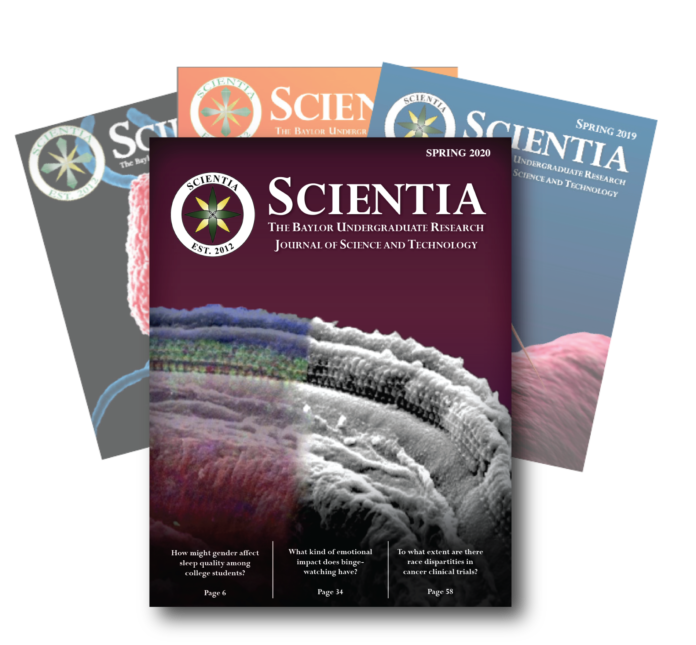
By Bridget Sjoberg | Editor-in-Chief
The Spring 2020 edition of Scientia, Baylor’s undergraduate research journal, was published last week and features student research on topics ranging from the impact of social media on short-term memory to the use of fashion therapy for mental health.
Scientia is published once a year and is produced by Baylor Undergraduate Research in Science & Technology (BURST). Houston freshman Isha Thapar, an editor for the publication, said that Scientia gives undergrads an opportunity to pursue research and opportunities in science and technology.
“Scientia is produced by BURST and gives undergrads the opportunity to showcase their research and all the hard work they do at Baylor,” Thapar said. “We publish anything about science and technology, from chemistry to anthropology. Our goal is twofold — to increase awareness of all the amazing research done at Baylor and to encourage other undergrads and readers to pursue research and all the opportunities Baylor offers.”
Thapar said that the publication is solely online this year due to COVID-19, and that a newsletter is published in the fall with information on research and internships.
“In spring, we usually have print copies and have it online. This semester we are only having it online because we can’t distribute print copies,” Thapar said. “In the fall, we started a newsletter which publishes articles about people’s summer research experiences and internship opportunities available to students.”
Katy junior Sean Ngo is the editor-in-chief of Scientia’s Spring 2020 edition, and is in charge of communicating with contributing authors, assigning editors to authors and helping with publication design.
“In the fall, we have authors submit an application to our website with articles that have their abstract and methods,” Ngo said. “We review all of that with our editorial board and vote on which ones should be published. Once we accept the ones we choose, in the spring we assign each author a few editors to help them review their articles. We also have full-time faculty editors who help us out by using their expertise to help revise articles.”
This year’s faculty editors were Dr. Tamarah Adair, Dr. Patrick Farmer and Dr. Linda Olafsen. Ngo said that Scientia is unique in that it specifically highlights research completed at the undergraduate level.
“One of the nice things about our publication and organization is that we focus on undergrads,” Ngo said. “Some things to achieve R1 research status are focused on graduate school and faculty, but we promote that research at the undergraduate level can also help build up our reputation as a university that is known for research. We can develop those students who will then go on to do great things in graduate school or other professional schools.”
Thapar said that design is also an important part of production and that a contest is used to determine the front cover image. This year’s cover features an electron microscopy image of a mouse cochlea taken by Preston Simpson as part of an experiment in Dr. Dwayne Simmons’ lab.
“The editor-in-chief leads the design committee, and after all the articles are edited, we work on compiling them into Adobe InDesign and Illustrator to make the graphics clear and make it all look as professional of a research paper as we can,” Thapar said. “The cover photo is cool too — we have a contest for students who want to submit a potential cover photo and then we choose one.”
There will be a cover image contest this fall open to anyone who has an image from their research lab that they would like featured as the 2021 Scientia cover. Prizes also include a Visa gift card and BURST merchandise.
Articles in this year’s Scientia edition focus on a variety of topics in subjects like physics, anthropology and biology. Ngo said two that stood out to him were Daniel Zeter’s original research with Dr. Michael Scullin titled “Sleep, Social Media, and Stress: Gender Disparities in Sleep Quality Among College Students,” and Arvind Muruganantham’s article titled “Endothelial Cell Diversity & Heterogeneity.”
Ngo and Thapar will serve as co-editors for next year’s Scientia edition. The Spring 2020 edition’s editorial board this year also included Shubhneet Warar, Arvind Muruganantham, Tiffany Luan, Sanjana Ade, Isha Thapar, Timothy Domashevich, Joshua George, Sinchana Basoor and Tooba Haris. Design team members include Muruganantham, Luan, Ade, Thapar and Basoor.
The Spring 2020 edition of Scientia can be accessed online. The guidelines for applying to be included in Scientia’s 2021 edition will be released this fall on the current BURST website, and all questions can be answered at baylor.scientia@gmail.com.





